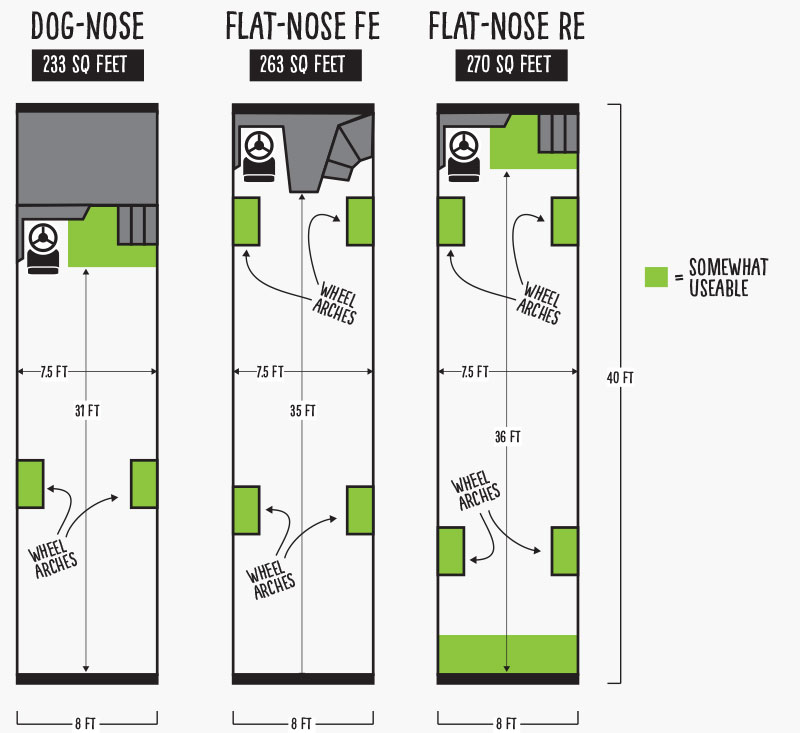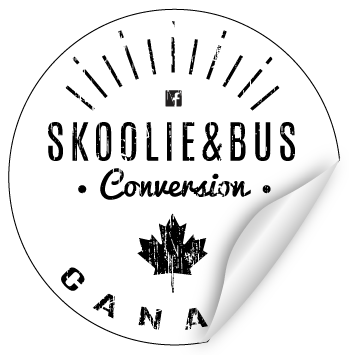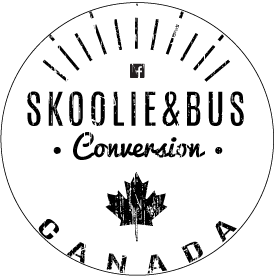

Kijiji is a free Canadian platform on which you can find various used treasures often inexpensive. There are various useful categories for the skoolie enthusiast such as the obvious, Cars & Vehicles, and also a potentially good place to find tools needed to build your new home. All provinces are available for your research and you can focus on cities as well!

Craigslist is a mostly American, but also Canadian classified advertisement website with useful sections like the For Sales but also potentially the service section for guidance or professionals offering their skills. Find your dream bus on craigslist either in Canada or you might be willing to take a gander at our neighbours to the south.

GC Surplus is the Canadian government’s surplus outlet. On this platform, the government sells, via auction, various products including vehicles like school buses. The government requires users to register on the site prior to being able to bid on products and a simple form is required to be a registered user. You might like to look under the Heavy Equipment category to find you dream home!
Ritchie Bros. is a global leader in asset management and disposition, and the world’s largest industrial auctioneer. We help thousands of people around the world appraise, sell, inspect, buy, refurbish, ship and finance heavy equipment and trucks every month. With our multiple selling platforms and commitment to first-class customer service, Ritchie Bros. is trusted worldwide because we make buying and selling easy, efficient, fair, and transparent.
Enchères publiques organisées par la Disposition des biens au Québec.
http://www.dispositiondesbiens.gouv.qc.ca/citoyens-et-entreprises/ventes-a-lencan.html

Junkyards can be a great source for finding those rare parts and sometimes costly larger pieces. You could also potentially find a complete bus in good enough condition. However, remember that junkyard vehicles are often subject to much more rigourous inspections in order to put them back on the roads, and that is if your province allows scrappers back onto the road. Call around your city to find the nearest retired bus lot!

There are various private companies that sell buses that they have gathered from school boards, transit companies, and multitudes of other sources. Buses could potentially be inspected and even come with a certain warranty.
One example could be National Bus Sales which is available across the continent.
The first thing you’ll want to decide on when choosing a bus is what length you’re looking for. School buses max out at 40ft, so if you’re looking for as MUCH space as you can, look for a 40-footer. Or on the other end of the spectrum, you can get a short bus – either a van conversion or cutaway (basically, a Ford or GM van front-section with a steel or fiberglass bus back-section) or a Type B short bus (usually looks like a full-sized dog-nose bus, but shorter, and weighing less than 21k lbs).
The two primary full-sized body styles are the conventional dog nose (Type C) with the hood out in front of the driver and the entrance behind the front wheels, or a flat nose, with no hood at all (Type D), which can be front-engine (FE), rear-engine (RE) or mid-engine, both with the entrance in front of the front wheels.
The obvious draw to having a full-sized bus is the increased floor space you have to work with (up to a max of about 270sq ft of useable space). A shorter bus is easier to navigate, park in neighborhoods (or your driveway) and usually gets better fuel mileage. Most full-timers will go for a longer bus, and if you’re just looking for a weekend camper, you might be fine with a shorter one.
When looking for a bus, you’ll often see them listed by how many passengers they carry, rather than length. 84 passengers typically means a full 40ft bus. That’s counting 3 kids to a seat, so 14 rows.
Source: Buslandia
Each bus type presents different challenges when you go to layout your floor plan. Make sure to take into account the wheel arches and engine cover, and on front-engine buses, the fact that you have a driveshaft and exhaust running down the center under you bus might limit where you can put your water tanks or storage compartments.
Use the information beside to pick which type of bus you’re after, keeping in mind that there each manufacturer is slightly different, and there are exceptions to some of these pros/cons.
Source: Buslandia

PROS OF A CONVENTIONAL DOG-NOSE
- Good for backroads (best approach angle and good clearance)
- Easily accessible engine
- Rear door allows for creation of garage/storage space
- Only 2 wheel arches to build around
- Classic “school-bus look”
CONS OF A CONVENTIONAL DOG-NOSE
- Drive shaft and exhaust run length of bus, limiting under-storage/tank options
- Can have poor departure angle on the longer Type C buses
- Less interior space than a flat-nose of same length
- More likely to get rejected from RV park
A conventional school bus tends do have better ground clearance, and a better approach angle, since the front wheels are further forward, making them better for going off the beaten path. That being said, on a full 40ft bus, the rear overhang on a conventional bus can be so long that you’ll drag your tail easily, and might not have any extra off-highway capabilities compared with a flat nose. The engine is also very accessible on a conventional bus.The downside to a conventional bus is that you lose about 40sq feet of floor space since part of your length is used up by engine, and isn’t interior space. But this is probably your best bet if you’re going to be off the beaten path frequently, and the ability to build a garage/storage area accessible from the back door is a huge feature for some people (especially those who have a lot of outdoor gear).
Source: Buslandia

PROS OF A FRONT-ENGINE FLAT-NOSE
- More interior space than a conventional bus of same length
- Rear-door allows for creation of garage/storage space
- Good front visibility
- Less likely to be rejected at RV park (compared to a dog-nose)
CONS OF A FRONT-ENGINE FLAT-NOSE
- Drive shaft and exhaust run length of bus, limiting under-storage/tank options
- Poor departure angle on the longer buses
- The noisiest/hottest option when driving (engine hump is right beside driver)
- 4 wheel arches to build around on the interior
An FE bus is usually built pretty similarly to a conventional bus, except you have more interior space. Downside is that you have a large engine hump next to the driver, which creates a lot of extra noise and heat. But if you’re looking for maximum square footage while keeping the rear-door access options, this might be your best bet.
Source: Buslandia

PROS OF A REAR-ENGINE FLAT-NOSE (TRANSIT)
- More interior space than a conventional bus of same length
- Quietest option while driving
- Tend to have longer wheel-base, smoother ride
- No driveshaft/exhaust running under bus, so better storage/tank installation options
- Typically has better departure angle than same length FE bus
- Good front visibility
- Less likely to be rejected at RV park (compared to a dog-nose)
- Best traction, with weight of engine over drive wheels
CONS OF A REAR-ENGINE FLAT-NOSE (TRANSIT)
- No rear door, so no good option for garage (they’ll have a side emergency exit towards the rear, so you can still have another entrance, just more difficult to turn into garage/storage area)
- Often have lower ground clearance due to storage bays
- Engine hump in the rear limits rear floor options
- 4 wheel arches to build around
A RE flat nose usually has a smoother, quieter ride, since the engine is located at the opposite end of the bus from the driver. Probably the best option for a highway cruiser, or if you’re trying to get the absolute most amount of living space out of your bus. A misconception is that the engine is harder to work on—however with rear and side engine door access, it’s usually not an issue. You do lose floor space in the rear where the engine box is located, but usually can still make use of the space by installing a bed or storage above it. As long as you make use of the space above the engine, an RE flat-nose gives you the most floorspace of any model of the same length. Another advantage is that with the engine located behind the rear axle, there is no driveshaft or exhaust running under the bus, which means this option has the most freedom for designing the layout of your bus, and for massive underbelly storage. One major drawback for some people is the lack of a rear door—so for those of you hoping to install a back porch, or a “garage” area, it’s much more complicated.
Source: Buslandia

Don’t get a gas engine unless you have some really crazy excuse.
Like the bus belonged to your grandpa and you’ve got a sentimental attachment to it. Or it’s a one-of-a-kind bus and you fell in love with this particular one. Other than that, go with diesel. End of story.
Diesel will get better mpg (usually between 7-12mpg vs 4-8mpg on a gasser) – that means that every 1,000 miles you drive will cost and extra $500-ish. That adds up quickly. Diesels will usually last longer as well so buying a properly maintained diesel with 200k miles on it shouldn’t concern you as much as buying a properly maintained gas bus with the same mileage. For those reasons, we won’t go into the details on gas engines, but will focus on diesels. Not that they can’t be fine engines, but in the used market a diesel isn’t that hard to find, nor much more expensive.
If you’re mechanically inclined, and want to do your own work on it, you might want to try to locate an older pre-electronics engine—that’ll be easier to work on and parts will be cheaper overall. But those are getting harder to find (anything 20yrs old or less is electronic). And the newer engines are cleaner, more efficient, and if you’ll be having a shop do the maintenance on it anyway, the higher cost of repairs probably won’t be that noticeable.
Okay, let’s jump into some of the common engines you’ll run into as you look for a bus:
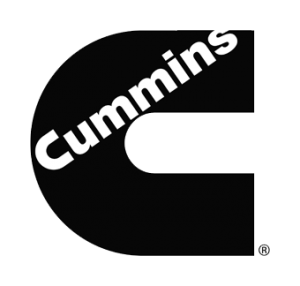
Cummins 8.3
-
C8.3 FIRST INTRODUCED IN 1985 / ELECTRONIC VERSION (C8.3E) INTRODUCED IN 1996
-
HP: 210 TO 300HP
This and the Navistar DT466 seem to be the most desired engines in school buses (especially configured with the higher power rating which has a lot of torque.) Easy to find someone to work on it, easy to find parts, and the cost of parts isn’t ridiculous (especially the non-electronic version). Doesn’t seem to be very common in FE buses.
Cummins 5.9
-
6BT 5.9 FIRST INTRODUCED IN 1989 / ELECTRONIC VERSION (ISB 5.9) INTRODUCED IN 1998
-
HP: 160 TO 180 (1989-1998)
-
HP: 215-325HP (1998-2007)
Most school buses with this engine seem to be in the lower horsepower rating—meaning this would be a somewhat underpowered engine for a full-sized bus. That being said, if you’re not planning on doing a lot of driving, this might be fine for you. VERY common to find this engine in buses, which means parts are plentiful (as are mechanics familiar with it). A bit better fuel economy than the 8.3 liter Cummins.

Navistar DT466
-
FIRST INTRODUCED IN 1984 / ELECTRONIC VERSION (DT466E) INTRODUCED IN 1994
-
HP: 165 TO 270HP (190 & 210 BEING THE MOST COMMON)/ TORQUE: 500-860LBF
This engine has been around a long time, and has a reputation as a rock-solid engine, relatively inexpensive to maintain. One of the most desirable engines you can commonly find, especially if it’s configured for the higher power levels.
Navistar T444e
-
1994-2004
-
HP: 210-275
An okay engine, but most people would choose something else if they had the choice.
Although some people absolutely love these engines, a Cat engine would probably be my last choice—not because it’s not a good engine, but because I hear a lot of reports of them being more expensive to repair, and really needing to be properly maintained (so if you don’t have any maintenance records on them, be careful). That being said, a well-maintained Cat can be a great engine, so don’t be too afraid of it!

Detroit Diesel (6v92, 6v71, etc)
If you’re purchasing an older bus (pre 1993), you might see some Detroit Diesel 2-strokes in them. These can be fantastic engines, just realize that finding mechanics to work on them can be tricky. These engines were in highway buses for decades, and when properly maintained, will probably outlast any of the other engines on this list (common to see these with 500,000+ miles on them). Read up on 2-stroke Detroit Diesels a bit before you get one of these, and make sure the pro/con list is worth it to you.
There’s a cult following though, so if you do find yourself with one of these engines, join one of the Facebook groups or forums, and you’ll have plenty of info at your fingertips.
Source: Buslandia
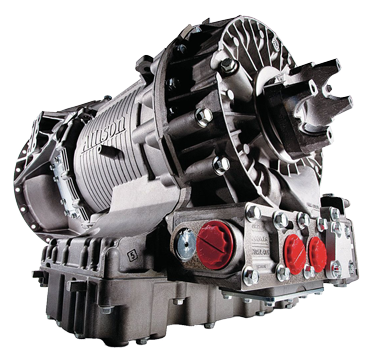

Allison AT545
This is an automatic 4 speed transmission. The base model, and very common. Not the greatest tranny for a full-sized bus, but probably fine in short buses with a smaller engine (like the Cummins 5.9). This is one of the only transmissions that *might* be a deal-breaker for you when looking at a bus, since it doesn’t have a lock-up torque converter in any gears, which means it’s a different animal from the other trannys—especially on mountain driving where it’ll generate more heat due to slipping.
Allison MT643
A medium duty automatic 4 speed, but with lock-up torque converter in the 3rd and 4th gears, making it more slightly more efficient, and maybe more importantly reduces the amount of heat generated, resulting in a more reliable transmission.This is a heavier duty tranny than the AT545.
Allison MD3060
I’ll list this one on it’s own since it seems to be one of the most common of the 3000 series. This automatic tranny is usually setup as a 5 speed (1 overdrive gear), but it actually has 2 overdrive gears (making it a 6 speed). You’ll have to have an Allison dealer unlock the 6th gear if yours doesn’t have it unlocked. Usually you can only get it unlocked for a RE bus. But even with just the single overdrive, this is a good tranny.
Allison 1000, 2000, 3000 series
These are all 5/6 speed overdrive automatics, and good transmissions. The difference between them is the weight/hp limits. If your bus/engine combo came with it from the factory, you’ll be fine.
Allison HT740
This is a heavy-duty automatic 4 speed transmission, not common on school buses, but older Crowns or Gilligs will have it, It has lock-up in all gears, and is a very reliable transmission.
REAR DIFFERENTIAL RATIOS
Since buses are often configured for lower speed driving (stop-and-go in-town driving) if you want to make sure you’ve got one that’s ideal for highway driving you’ll want to check the rear end ratio (it’s not just the transmission that makes it a good highway rig).
The lower the rear-end ratio, the higher speeds you’ll be able to attain (and the lower the amount of power you’ll have at low speeds). Common ratio’s are 3.73, 4.10, 4.33, 4.44, 4.56, 4.75, 5.57, and 6.5. If you’ve got 4.33 or lower rear-end ratio gears, you’ve got a good highway machine. 5.57… not so much, but if you’re not in a hurry to get anywhere it’s not a big deal.
Source: Buslandia
Coming soon.
If you have any information about the registration in this province, feel free to contact us ! !
Definition of a motor home (vehicle type 5)
Motor home means a motor vehicle designed or used primarily for accommodation during travel or recreation, but does not include a motor vehicle that has attached to it a structure:
• designed or used primarily for accommodation during travel or recreation, and
• designed or intended to be detachable
This exception is intended to exclude campers mounted on pickup trucks from motor home status.
Design requirements
ICBC interprets “designed primarily for accommodation” to mean a motor vehicle that has sleeping facilities and at least three of the following attached to the chassis in a manner that requires a tool for removal:
• cooking facilities
• refrigeration or icebox facilities
• self-contained toilet (not capable of easy removal like a porta-potty type)
• heating or air conditioning facilities independent of the vehicle’s motor
• potable water supply system including a faucet and a sink
If the vehicle that you are registering cannot meet the qualifications that “designed primarily for accommodation” requires, the body style would likely be one of the following:
• a station wagon
• a van or window van
• a leisure van
When registering a motor vehicle designed or used primarily for accommodation during travel or recreation, use body style MOHOM and body style code 60.
Van or bus conversion
Converted vans and buses may be registered as motor homes, provided they meet the design requirements and the living quarters are permanently attached to the vehicle. This may include vehicles described by motor dealers as campers/campwagons or van conversions.
Structural changes require a “passed” BC Vehicle Inspection Report (CVSE0013 or CVSE0014) if not completed by a Transport Canada-approved secondary vehicle manufacturer or if the vehicle is classed as a ubilt.
What qualifies as a motor home
The Motor Vehicle Act describes a motor home as a vehicle that is primarily used and designed for accommodation during travel and recreation. If you are unsure whether a vehicle qualifies, pictures may be helpful, especially for ubilt motor homes. Start by looking for a door, windows, ventilation for cooking, and a bathroom.
Fixtures
Certain fixtures must be attached in a way that requires tools to remove them. ICBC also require that the vehicle modifications will meet Canadian Motor Vehicle Safety Standards as established by Transport Canada and that all the fixtures and materials, including plumbing and wiring, will be Canadian Standards Association (CSA) approved. For contact information, see Canadian Standards Association .
Water Supply
A potable water supply means fresh water for drinking. This supply would be kept in a sanitary holding tank that will prevent contamination and should utilize a pump operated by a deep cycle storage battery to deliver the water to a sink, shower, or toilet. Just bringing a hose to the side of the vehicle is not acceptable. It must have its own independent water supply. Note, though, that many RV parks do provide fresh water hookups, and this is acceptable.
Cooking facilities
As a minimum, the cooking facilities should include a refrigerator, cooktop, and a stove or microwave. A propane tank installed under the vehicle usually fuels appliances. The entire propane installation must be certified as safe by an inspector approved by the Gas Safety Program. For contact information, see BC Safety Authority . The fridge may use electricity (12 VDC or 110 VAC) as an alternate source of power, and many do, but must also be able to operate independently. The interior lighting and, sometimes, a microwave, will operate off a deep cycle 12 volt battery. Many RV parks provide electrical hookups as an alternative to the battery or an onboard generator.
Heating and air conditioning
The heat source that we ask for is usually attached to the propane system. A thermostat within the vehicle is used to regulate the temperature. An electrical heater powered by an external source does not qualify as the primary heat source. The air conditioning unit is usually mounted on the roof of the vehicle and is separate from the air conditioner that is powered by the vehicle’s motor and used while travelling. The air conditioner for the living quarters is usually powered by electricity.
Holding tanks
With a sink and a shower, we also expect that there will be a grey water tank under the vehicle to hold the water until the next sani-station. With a toilet, we would insist on a black water tank under the vehicle to hold the sewage until the next sani-station. Without these tanks, the sink, shower, and toilet would have to be considered as incomplete and unusable.
Coming soon.
If you have any information about the registration in this province, feel free to contact us ! !
Coming soon.
If you have any information about the registration in this province, feel free to contact us ! !
Coming soon.
If you have any information about the registration in this province, feel free to contact us ! !
Coming soon.
If you have any information about the registration in this territory, feel free to contact us ! !
Coming soon.
If you have any information about the registration in this territory, feel free to contact us ! !
A motorized mobile home is a self-propelled passenger vehicle that is a temporary/permanent residence containing any 4 of the following:
- cooking facilities
- refrigerator/ice box
- self-contained toilet
- heating/air conditioning
- portable water supply system including faucet and sink
- independent electrical power/gas supply
Generally, when converting a vehicle from a commercial or bus class to a passenger class (i.e. motorized mobile home) the following information must be presented at ServiceOntario to have it registered for road use:
- Vehicle permit (ownership) – the ‘Application for Vehicle Transfer’ located on the back of the vehicle permit must be completed if you have recently purchased the bus/commercial vehicle.
- Proof of purchase (e.g. ‘bill of sale’)
- Proof of insurance – you must to obtain insurance from a private insurance company licensed in Ontario. You can discuss the requirements for obtaining insurance with the private insurer.
- Safety Standards Certificate (if vehicle is to be registered as fit) – https://www.ontario.ca/faq/whats-safety-standards-certificate
- Written declaration which states:
- full description of the vehicle make, model (if available), year and Vehicle Identification Number (VIN)
- description of change and equipment, if installed/removed
- that the changes made to vehicle meet the criteria for the new class.
More info (Thanks to Sarah Fenix!).
You need a letter of affidavit stating your bus has the following things (same than above) :
- A contained toilet
- Refrigeration system
- A heat and or air con source
- A independent electrical source such as a solar panel
- A sink, facet and running water
- A cooking facility such as a hot plate
Plus anything else you modified. You just need to sign it but it does not need any other signatures.
You can take that to the MTO to change the slip. It costs $30. You ask to change bus to RV status.
If you already have a safety than you don’t need to pay the 30. Just $57 for the plates if you don’t have some and $120 for the sticker for the year. This requires your insurance in place first.
If your not ready for a safety or you need to show insurance you green slip. Than you can get the green slip first. Its just an extra $30.
Coming soon.
If you have any information about the registration in this province, feel free to contact us ! !
HEAVY VEHICLES CONVERTED INTO MOTOR HOMES FOR PERSONAL USE
If you convert a heavy vehicle into a motor home for personal use, you must comply with several requirements to be authorized to put the vehicle back into operation.
MODIFYING OR HAND-CRAFTING A VEHICLE
Before converting a heavy vehicle into a motor home, you must know the procedure to follow:
CHARACTERISTICS OF A HEAVY VEHICLE CONVERTED INTO A MOTOR HOME
MAXIMUM LENGTH
The maximum length is generally determined on the basis of the rear overhang, namely:
- 12.5 metres for all motor vehicles with a rear overhang of 4 metres or less
- 14 metres for all buses with a rear overhang of 4 metres or less
- 11 metres for all other cases
If you plan to hitch a trailer to the vehicle, its total length is also limited. See the Vehicle Load and Size Limits RegulationThis link will open in a new window.
The rear overhang is measured from the centre of the axle or axle group to the rear end of the vehicle (including the bumper and load).
CARGO SPACE
If the motor home has cargo space, it must not exceed 30% of the length of the vehicle or 3.65 metres.
DRIVER’S COMPARTMENT
The driver’s compartment must be part of the living space. In addition, it must be readily accessible in an upright position from the inside of the vehicle.
FIFTH WHEEL
A fifth wheel, or a place to attach one, is not accepted on a hand-crafted motor home.
MANDATORY EQUIPMENT
BASIC COMPONENTS
- A kitchen that includes a stove, refrigerator, counter, sink and table
- Sleeping quarters that include a hide-a-bed or bed
- A complete bathroom that includes a shower and a toilet with a permanent hook-up to a drainage system
- An electrical system that is independent of the vehicle’s motor
- A propane gas system with a certificate of installation compliance
- A potable water tank
- A sewage tank
- A water heater
- A heating system that is independent of the vehicle’s motor
- A minimum of two seats with seat belts
- A number of seats and seat belts greater than or equal to the number of places to sleep (maximum 9)
SEATS FOR PASSENGERS
A heavy vehicle that is converted into a motor home must be designed to seat no more than 9 occupants, including the driver. Every seat must be equipped with a seat belt:
- If the original vehicle was equipped with seats that did not have seat belts (a school bus, for example), those seats must be taken out of the vehicle
- Seats and seat belts must be new, designed for this type of vehicle and installed by a certified installer according to the manufacturer’s specifications
- A 3-point seat belt is required for all seats whose back rest is perpendicular to the road. A 2-point seat belt is permitted for the other seats (arranged lengthwise)
Only equipment designed specifically for installation in a recreational vehicle is accepted. To know more about what equipment may be installed, other than mandatory equipment, please refer to what is offered by the large manufacturers of recreational vehicles. Any unusual or unconventional equipment will be refused.
Seat belts
Installing seat belts on seats that were not designed for this type of device is prohibited.
We may request information on the purchase, origin and installation of the vehicle’s seats and seat belts.
DETECTORS
We strongly recommend installing carbon monoxide, smoke and propane detectors in a motor home.
BEFORE TRAVELLING IN YOUR MOTOR HOME FOR PERSONAL USE
If we conclude that the vehicle meets road safety standards, we will issue you:
- a valid mechanical inspection certificate
- a certificate of inspection that confirms:
- the presence of mandatory equipment
- the compliance of the equipment and modifications
The certificate of inspection must be kept on board the vehicle at all times.
VEHICLE REGISTRATION
Once the conversion has been approved by the SAAQ, the vehicle may be registered just like any other motor home.
Required documents
When you change the vehicle’s licence plate, you must show:
- the valid mechanical inspection certificate
- the certificate of inspection
CLASS 5 DRIVER’S LICENCE
A Class 5 driver’s licence is required to drive a motor home.
A motorhome is a motor vehicle that is designed for personal accommodation. Motorhomes are equipped with 1 or more permanently attached beds and at least 2 of the following permanently attached appliances:
- a refrigerator wired into the motorhome’s electrical system
- a stove
- a toilet and washing facility
Motorhomes and recreational trailers, need to be manufactured to either the CSA Z240 RV standard or the National Fire Protection Association (NFPA) 1192 standard. This includes homebuilt motorhomes and RV trailers. You should check to ensure you have a label of compliance before registering your recreational vehicle.
A motorhome may be a manufactured unit or a vehicle such as a bus or van that has been converted to a motorhome. For more information on these standards and their application contact Vehicle Standards and Inspections.
Registration
To register your motorhome, visit your local motor licence issuer with your vehicle renewal notice. Your motor licence issuer will ask you to provide the following information:
- the gross vehicle weight (GVW) of your motorhome
- the value of your motorhome
First time registration
If it is your first time registering the motorhome, your motor licence issuer will also require the following:
- The bill of sale (pdf, 12kb).
- An Inspection Certificate, if the vehicle was a total loss or was purchased outside of Saskatchewan.
- A Vehicle Import form from Canada Customs, if the vehicle was purchased outside of Canada.
Class LV and PV insurance premiums
Class LV and PV insurance premiums apply to all vehicles registered in Class LV and PV, which includes motorhomes as well as buses and vans that are used as motorhomes.
Your insurance premium is based on the value you declare for your motorhome at the time of registration. To determine your premium, find your motorhome’s value on the guide below:
|
Insurance Premium Guide
|
|||
| Value of Motorhome | Premium | Value of Motorhome | Premium |
| $10,000 and under | $267 | $125,001 – $150,00 | $987 |
| $10,001 – $20,000 | $362 | $150,001 – $200,000 | $1,090 |
| $20,001 – $30,000 | $565 | $200,001 – $250,000 | $1,101 |
| $30,001 – $50,000 | $571 | $250,001 – $300,000 | $1,140 |
| $50,001 – $75,000 | $779 | $300,001 – $400,000 | $1,161 |
| $75,001 – $100,000 | $789 | $400,001 – $500,000 | $1,191 |
| $100,001 – $125,000 | $923 | Greater than $500,000 | $1,217 |
U-Drive
If you will be renting out your motorhome, add an additional 15% to the insurance premium listed above.
Safe Driver Recognition discount
Your Safe Driver Recognition discount can be found on the front of the vehicle renewal notice, under the heading Recognition Program.
You can also find out your Safe Driver Recognition discount by signing into MySGI or calling our Customer Service Center at 1-800-667-9868.
Calculating motorhome fees
If you would like to calculate the cost of registering and insuring your motorhome, follow the steps below:
- Determine your gross vehicle weight (GVW) from the Motorhome GVW guide.
- For example, a Class C style motorhome that is 25 to 31 ft long averages in weight from 4,762 kg to 6,373 kg. If your motorhome is 28 ft long, estimate a figure within that weight range, such as 6,000 kg.
- Find your registration fee on the registration fee guide.
- For example, the registration fee for a motorhome with a GVW of 6,000 kg is $112.
- Find your insurance premium on the Insurance premium guide.
- For example, if your motorhome is valued at $25,000, your insurance premium would be $565.
- Deduct your Safe Driver Recognition discount (if applicable) from the insurance premium (not from the registration fee).
- For example, if your Safe Driver Recognition discount is 12% and your insurance premium is $565, you would deduct $68 ($565 x .12 = $67.80).
- If you are renting out your motorhome(U-Drive), add 15% to the insurance premium.
- For example, if your insurance premium is $565, you would add $85 ($565 x .15 = $84.75).
|
Sample motorhome fee calculation
|
|
| Registration fee | + $112 |
| Insurance premium | + $565 |
| Safe Driver Recognition discount (if applicable) |
– $68 |
| U-Drive fee (if applicable) | + $85 |
| Total | = $694 |
Source: https://www.sgi.sk.ca/individuals/registration/guidelines/motorhomes/
Coming soon.
If you have any information about the registration in this territory, feel free to contact us ! !






